SAFETY MEASURES DURING EBOLA OUTBREAK
INTRODUCTION
Before the official “SMS era”, IATA Operational Safety Audit – IOSA, required preparedness for possible case(s) of communicable disease (or other public health risk) on board. Emergency response procedures defined in Emergency Response Manual (ERM) should be in compliance with applicable international standards and regulations (ICAO, IATA, WHO) and national requirements (EASA, European Aviation Crisis Communication Cell - EACC, CAA and National Institute of Public Health).
Real implementation of these requirements in most airlines actually started for the first time as a part of response to the Ebola outbreak in 2014. System established at that time in our company (and on the state level) has been later tested (and improved) in some real cases of transporting passengers infected by measles virus.
I believe that experience and lessons learned from the Ebola outbreak shared in this blog might be useful for establishing safety controls for novel COVID-19 disease once this suspended and drastically reduced airlines operations ends.
ORGANISATION, EMERGENCY RESPONSE AND SAFETY MEASURES
In our company Safety Manager was responsible for the establishment of Emergency Response Policy and Plan, while Emergency Director was responsible for operational implementation of the airline preparedness plan. Communication Chart in case of suspected communicable disease (or other public health risk) on board of an aircraft has been clearly defined; starting with primary info, followed by emergency response activating phase inside the first hour of the system response and stabilised in form of established emergency communication.
Crew members, specially Cabin crew members in details, were clearly instructed and trained how to: (a) identify travelers suspected of having a communicable disease, (b) apply personal hygiene measures to reduce risk, (c) get medical advice, (d) relocate infected passenger, (e) use appropriate first-aid equipment and supplies, (f) implement general sanitary precautions, (g) use Universal Precaution Kit - UPK and Personal Protective Equipment- PPE for crew and passengers, (h) relocate cabin crew duties, (i) clean-up of affected areas and disposal of contaminated supplies and equipment.
Passenger locator cards - PLC with filling instructions printed on the back side of PLC have been invented to collect on board passengers’ contact information in order to be able to contact them later, if needed.
Pilots were instructed to notify ATC of any onboard suspected communicable disease, or other public health risk, so that the state health authority at the planned destination can be advised appropriately and in a timely manner.
Communication links with other service providers (e.g. Passenger and Cargo Handling Agents, Maintenance Organizations etc.) have been defined in order to provide them all known information about suspected disease and required protective equipment/precautions to be implemented, as recommended by medical experts from health authority.
If aircraft disinfection was required, appropriate competent companies were contracted to clean/disinfect the defined areas/surfaces using methods/procedures recommended by the health authority.
Also if needed, applicable maintenance organizations were engaged to remove re-circulated air filters or to vent off vacuum waste tanks or to perform any other required maintenance action.
During the Ebola outbreak it was extremely important having 24/7 available competent expert(s) (in most countries available only on state level), providing detailed guidance on how to respond in specific emergency occurrence to avoid overreacting/underreacting due to lack of expert knowledge and experience.
When we made our very first top level Safety Risk Assessment - SRA for Ebola, the comment from the expert was that we did a very good job for Super-Ebola which would spread in the form of aerosol. At the beginning we didn’t have clear answers to some important questions: (a) What might be considered as safety distance? 1 meter, 2 meters, 3 …, (b) What about outdoor distance and how it is affected by wind speed and turbulence, (c) How long can Ebola virus survive on different surfaces and how this is affected by temperature and humidity … . With the knowledge provided by domain experts we performed several iterations of our SRA until we finally established effective, reliable and practically doable safety controls.
For illustration, one of the very first controls considered highly effective was a medical skafander, but we discarded it very quickly, because it was not practical for onboard use. Even a trained pair of medical staff (one dressing it, another instructing and supervising her/him) needed about 20 minutes to dress it and about 25 minutes to undress it.
CONCLUSION
First lesson learned from the real situation was that one of the most important safety controls is to have ONE & ONLY ONE official communication system/protocol applicable for all internal and external communication on all levels. If effective, there will be no panic, because all people involved will be confident that the situation is managed by a multidisciplinary team of experts and responsible decision makers, resulting in trust and therefore reducing influence of fake news and other pathological opinions available on social media and media in general.
Availability of competent domain expert(s) needed for immediate reaction on operational events and proactively for SRAs are two main reasons why to integrate the company emergency team with a state emergency response system. This also applies for all others stakeholders need to be well prepared before you open a passenger door of your aircraft with a suspected case of communicable disease on board.
Continuation of operation with greatly reduced staff numbers has also been planned to be managed as part of Emergency Response taking into account actual external and internal circumstances. However, nobody thought at that time that this might mean what we experience today with the novel COVID-19 virus, when not only one airline, but almost all airlines completely (or in a dramatic extent) stopped their operations due to greatly reduced numbers of passengers.
Andrej Petelin
Aviation Safety and Compliance ConsultantMarch, 2020
